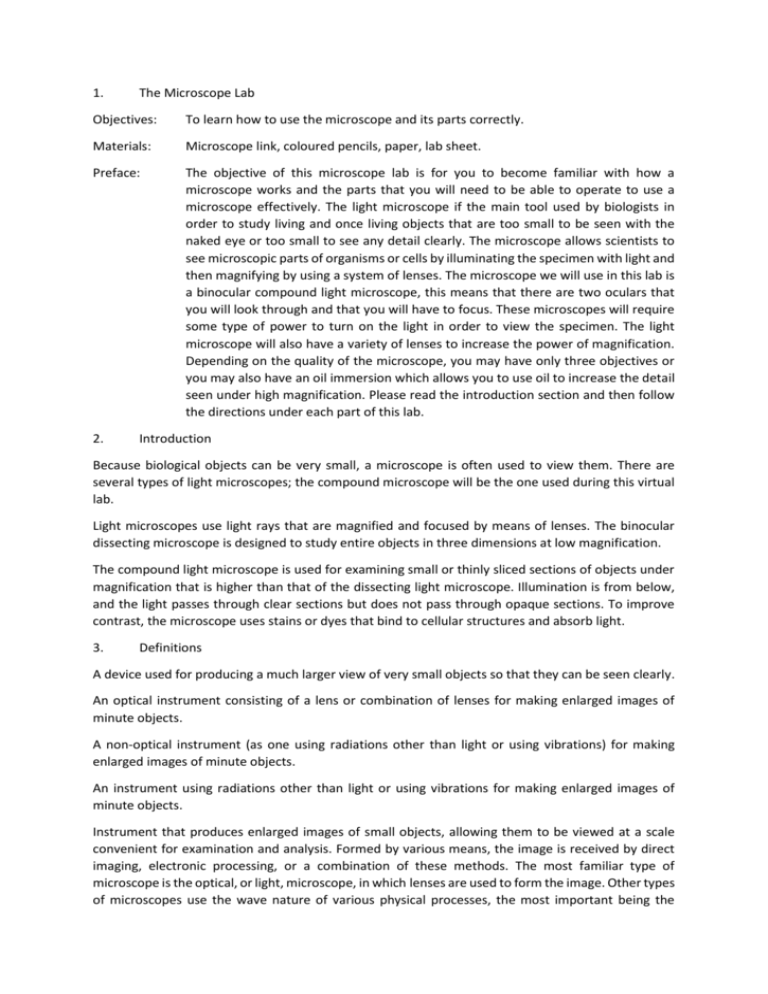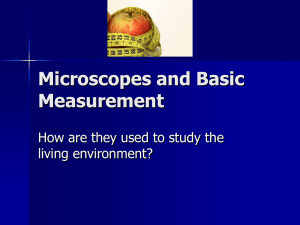1. The Microscope Lab
advertisement

1. The Microscope Lab Objectives: To learn how to use the microscope and its parts correctly. Materials: Microscope link, coloured pencils, paper, lab sheet. Preface: The objective of this microscope lab is for you to become familiar with how a microscope works and the parts that you will need to be able to operate to use a microscope effectively. The light microscope if the main tool used by biologists in order to study living and once living objects that are too small to be seen with the naked eye or too small to see any detail clearly. The microscope allows scientists to see microscopic parts of organisms or cells by illuminating the specimen with light and then magnifying by using a system of lenses. The microscope we will use in this lab is a binocular compound light microscope, this means that there are two oculars that you will look through and that you will have to focus. These microscopes will require some type of power to turn on the light in order to view the specimen. The light microscope will also have a variety of lenses to increase the power of magnification. Depending on the quality of the microscope, you may have only three objectives or you may also have an oil immersion which allows you to use oil to increase the detail seen under high magnification. Please read the introduction section and then follow the directions under each part of this lab. 2. Introduction Because biological objects can be very small, a microscope is often used to view them. There are several types of light microscopes; the compound microscope will be the one used during this virtual lab. Light microscopes use light rays that are magnified and focused by means of lenses. The binocular dissecting microscope is designed to study entire objects in three dimensions at low magnification. The compound light microscope is used for examining small or thinly sliced sections of objects under magnification that is higher than that of the dissecting light microscope. Illumination is from below, and the light passes through clear sections but does not pass through opaque sections. To improve contrast, the microscope uses stains or dyes that bind to cellular structures and absorb light. 3. Definitions A device used for producing a much larger view of very small objects so that they can be seen clearly. An optical instrument consisting of a lens or combination of lenses for making enlarged images of minute objects. A non-optical instrument (as one using radiations other than light or using vibrations) for making enlarged images of minute objects. An instrument using radiations other than light or using vibrations for making enlarged images of minute objects. Instrument that produces enlarged images of small objects, allowing them to be viewed at a scale convenient for examination and analysis. Formed by various means, the image is received by direct imaging, electronic processing, or a combination of these methods. The most familiar type of microscope is the optical, or light, microscope, in which lenses are used to form the image. Other types of microscopes use the wave nature of various physical processes, the most important being the electron microscope (see electron microscopy), which uses a beam of electrons in its image formation. Crude microscopes date to the mid-15th century, but not until 1674 were the powerful microscopes of A. van Leeuwenhoek able to detect phenomena as small as protozoa. 4. Parts to a Microscope Instruments that produce enlarged images of small objects, allowing them to be viewed at a scale convenient for examination and analysis. Formed by various means, the image is received by direct imaging, electronic processing, or a combination of these methods. The most familiar type of microscope is the optical, or light, microscope, in which lenses are used to form the image. Other types of microscopes use the wave nature of various physical processes, the most important being the electron microscope, which uses a beam of electrons in its image formation. Crude microscopes date to the mid-15th century, but it was not until 1674 where the powerful microscopes of A. van Leeuwenhoek was able to detect phenomena as small as protozoa. The picture of the compound microscope shows where these features are typically found. Please be aware that not all microscopes will look exactly the same so some of the features may be found around the general area, but may vary in placement. 5. Name that Part Microscopes have a variety of parts that must be used correctly before an image will become visible. Using a light microscope takes lots of practice that we can simulate using a virtual microscope. Arm – This part of the microscope essentially holds all of the other parts, and is used in the transport of the microscope. Base – This part of the microscope essentially holds all of the other parts, and is used in the transport of the microscope. Body – This part of the microscope houses the revolving Nosepiece or Turret and Objective Lenses. Brightness Control Knob and Power Switch – This knob controls the brightness of the light and also acts as the ON/OFF switch. Condenser Focus Knob – This knob is used to focus light properly on the mounted specimen. Condenser System – This is a system of lenses which helps to focus light directly on the specimen that is mounted on a slide. Coarse Focus Knob – This knob is located on both sides of the microscope and allows you to focus your image in the microscope. Diaphragm Lever – This lever is used to control the diameter of the diaphragm. Diopter Adjustment Ring – This ring is used to accommodate the fact that both of your eyes may not be focused the same. This ring is found on both Ocular Tubes. Field Iris Diaphragm – This system is used to vary the diameter of the Field Iris Diaphragm, limiting the amount of light passing through the Condenser System and the specimen. Fine Focus Knob – This knob “fine tunes” the focus of your specimen. Head – This part of the microscope contains a delicate prism system which helps to send an image to the oculars and your eyes. Mechanical Stage – This is where the specimen is placed for observation. With a slide in place, it can be moved in the X and Y directions using the Stage Control Knobs. Nosepiece or Turret – This part of the microscope contains four objectives at various magnifications. Objective Lenses – Your microscope is equipped with four objective lenses with magnifications of 4x, 10x, 40x and 100x. The 100x objective is an oil immersion lens. The longer the objective, the more magnification it has. Ocular Lenses – The oculars have lenses that magnify images 10 times (10x). Inside the right ocular is a pointer which can be moved by rotating the ocular. The right ocular is loose, while the left ocular is secured in place. This is for Kohler Illumination. The oculars sit in the Ocular Tubes. Ocular Tubes – The ocular tubes hold the oculars and can be adjusted for interpupillary distance. Interpupillary distance is the distance between your eyes. Power Cord – This supplies power to the microscope illuminator. Stage Clips – This part of the microscope holds the specimen in place on the Mechanical Stage. Stage Control Knobs – The X-Stage Control Knob will move a slide in the X-axis (horizontally). The YStage Control Knob will move the slide in the Y-axis (vertically) on the Mechanical Stage. Illuminator – Housing a 6V 20W halogen bulb within the base of the microscope, this system provides light for specimen illumination. 6. Test In order to answer the questions in this lab you will need your Answer Document which you can download by clicking here. Instructions on how to submit your Answer Document as well as any additional documents will be provided at the end of this lab. On your Answer Document identify the different parts of the microscope labelled below. 7. Total Microscope Magnification Total magnification is calculated by multiplying the magnification of the ocular lens (eyepiece) by the magnification of the objective lens. For instance if your ocular is 10x and low power is 4x the total magnification for that lens is 40x. Some microscopes allow you to use oil with the 100x magnification. The oil helps focus the light providing in depth detail on small specimens (i.e. bacteria). Answer the questions below, type all answers into the Answer Document under Part 2 – Total Microscope Magnification. For the Objective and Ocular Magnification questions, use the images to determine which Objective and Ocular lenses were used. Total magnification. To figure the total magnification of an image that you are viewing through the microscope is really quite simple. To get the total magnification take the power of the objective (4X, 10X, 40X) and multiply by the power of the eyepiece, usually 10X. The standard microscope is that the eyepiece is 10x magnification, and three types of powered magnification helps it magnify even more. Low power is 4x, Medium power is 10x, and High power is 40x. Eyepiece and Low power is 40x, Eyepiece and Medium power is 100x, and Eyepiece and High power is 400x magnification in revolance to the naked eye. The ocular lens are 10x magnification. Objective lens are 4x, 10x, 40x, 100x magnification. So once an objective lens is selected, the total magnification would be given by its product with the 10x magnification of the ocular lens. For example, if objective lens selected is 40x, total magnification would be: (10x)(40x)=400x total. 1. A microscope has an eyepiece lens with a power of 5X. The objective lens being used has a power of 10X. What is the total magnification? The total magnification = 50X. 2. A microscope has an eyepiece lens with a power of 15X. The objective lens being used has a power of 40X. What is the total magnification? The total magnification = 600X. 3. A microscope has an eyepiece lens with a power of 10X. The objective lens being used has a power of 10X. What is the total magnification? The total magnification = 100X. Objective and Ocular Magnification. Objective ^^^ <<< Ocular 4. The following slide is viewed under 400x. What is the magnification of the ocular and the objective used for 400x? Objective magnification used = 40X and ocular magnification used = 10X. 5. The following slide is viewed under 1,500X. What is the magnification of the ocular and the objective used for 1,500x? Objective magnification used = 60X and ocular magnification used = 25X. 6. The following slide is viewed under 600X. What is the magnification of the ocular and the objective used 600x? Objective magnification used = 60X and ocular magnification used = 10X. 7. The following slide is viewed under 500X. What is the magnification of the ocular and the objective used 500x? Objective magnification used = 20X and ocular magnification used = 25X. 8. The following slide is viewed under 200X. What is the magnification of the ocular and the objective used 200x? Objective magnification used = 20X and ocular magnification used = 10X. 9. The following slide is viewed under 10,000X. What is the magnification of the ocular and the objective used 10,000x? Objective magnification used = 100X and ocular magnification used = 100X. 8. Total Microscope Magnification Quiz Let’s do a quick recap of what you have learned so far before we begin the virtual lab by answering the questions below. All Pre Lab Questions should be answered under Part 3 – Pre Lab Questions of your Answer Document.







